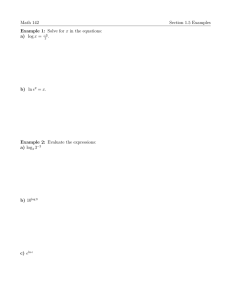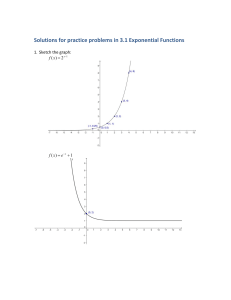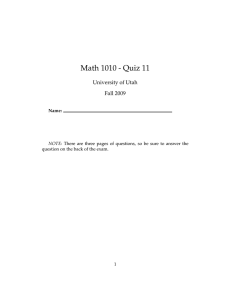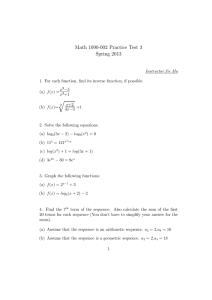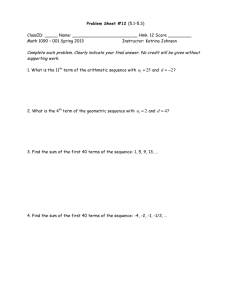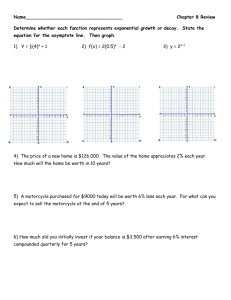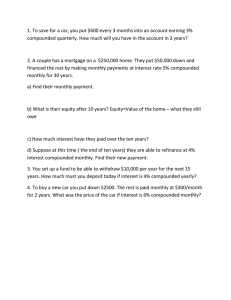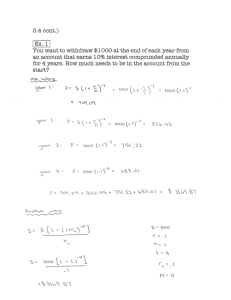Math 1090 Practice Test 3 13 April, 2012
advertisement
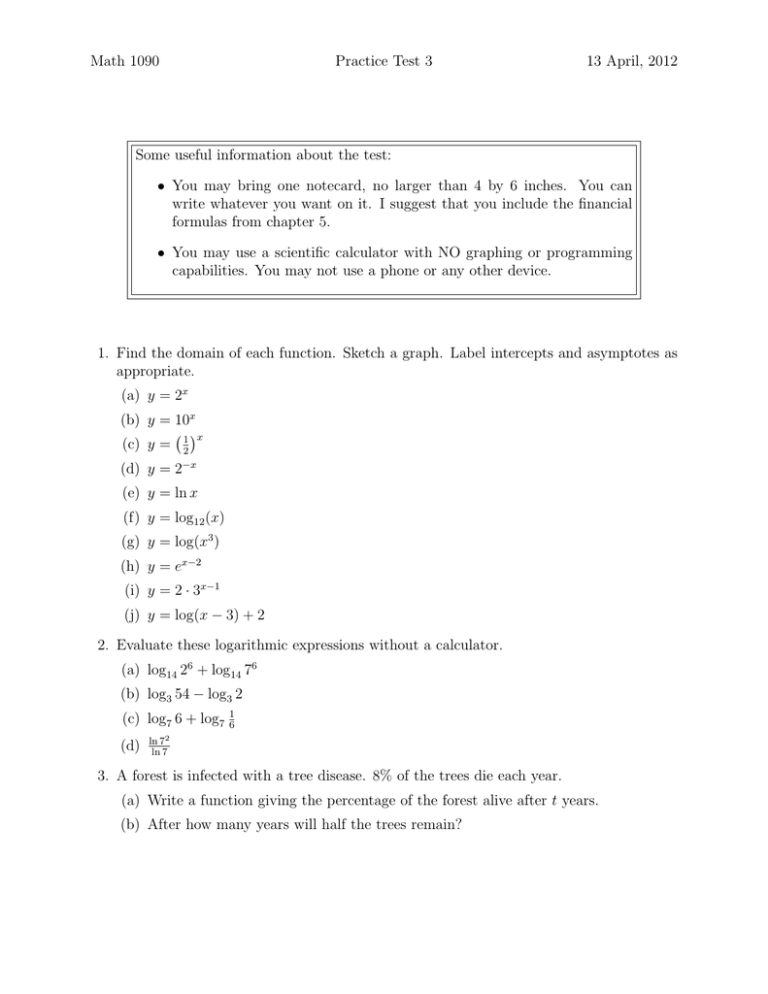
Math 1090 Practice Test 3 13 April, 2012 Some useful information about the test: • You may bring one notecard, no larger than 4 by 6 inches. You can write whatever you want on it. I suggest that you include the financial formulas from chapter 5. • You may use a scientific calculator with NO graphing or programming capabilities. You may not use a phone or any other device. 1. Find the domain of each function. Sketch a graph. Label intercepts and asymptotes as appropriate. (a) y = 2x (b) y = 10x x (c) y = 12 (d) y = 2−x (e) y = ln x (f) y = log12 (x) (g) y = log(x3 ) (h) y = ex−2 (i) y = 2 · 3x−1 (j) y = log(x − 3) + 2 2. Evaluate these logarithmic expressions without a calculator. (a) log14 26 + log14 76 (b) log3 54 − log3 2 (c) log7 6 + log7 (d) 1 6 ln 72 ln 7 3. A forest is infected with a tree disease. 8% of the trees die each year. (a) Write a function giving the percentage of the forest alive after t years. (b) After how many years will half the trees remain? 4. Expand each expression into the simplest terms possible. (a) log2 (x − 1)2 (x + 2) 3x (b) log5 (c) ln (x + 1)2 6yz x √ 2 x4 2x − 3 3 √ 3 4x + 2 5. Rewrite each exponential equation as a logarithmic equation. (a) 24 = 16 1 (b) 9 2 = 3 3 (c) 12 = 1 8 (d) ab = c 6. The magnitude of an earthquake is given by M = log II0 , where M is the magnitude, I is the intensity in joules, and I0 is the intensity of a zero-magnitude earthquake, I0 = 10−3 joules. (a) What is the magnitude of a quake with intensity 134,000 joules? (b) How many times greater is the intensity of a magnitude 5.3 earthquake than the intensity of a magnitude 3.3 earthquake? (c) How many times greater is the intensity of a magnitude 6.4 earthquake than the intensity of a magnitude 4.4 earthquake? 7. Solve each equation. (a) 3e2x − 7 = 11 (b) log2 (3x − 2) − log2 (x2 ) = 0 (c) log2 (logx (16)) = 2 (d) log(x2 − x) + log(2) − log(x) = 1 (e) ln ex + eln x + ln e = 5 2 (f) ex = e4x e12 (g) 114 = 121x 2 +x (h) 24x − 81 = 0 8. Use properties of logarithms to write each expression as a single term. (a) ln x2 + ln x3 + ln x4 + ln x5 (b) log3 4 + log3 x − log3 4x (c) log2 5 + log2 (x − 6) − 2 log2 (yz) + 3 log2 7 9. The half-life if Iodine-131 is 8 days. Suppose we have a 500 gram sample. (a) Write a function giving the amount of Iodine-131 remaining after t days. (b) How long will it take for half the sample to decay? (c) How much will remain after 90 days? 10. Evaluate each logarithm without a calculator. (a) log3 27 (b) log27 3 (c) log 1 1 4 (d) log2 1 2 2 (e) log 1 4 2 (f) log9 1 3 11. A certain population of bacteria triples every 6 hours. There are 400 bacteria initially. (a) Write a function giving the number of bacteria after t hours. (b) How long does it take the population to double? (c) How many bacteria will there be after 70 hours? 12. Rewrite each logarithmic equation as an exponential equation. (a) log4 2 = 1 2 (b) log6 36 = 2 (c) log16 64 = 3 2 (d) logx y = z 13. Use a calculator to approximate each expression to 4 decimal places. (a) log10 7 (b) loge 18 (c) log3 12 (d) log 1 6 2 14. Find the future value of an annuity due paying $1200 each month for 4 years if the the interest rate is 8.4% compounded monthly. 15. Sean’s parents loan him $10,000 for a trip to Australia. He plans to amortize the loan and pay it back to them in 10 equal quarterly payments. If their interest rate is 6% compounded quarterly, how much is each payment? 16. Jesse, in retirement, inherits $93,000 upon his mother’s death. He invests it at 6.6% compounded monthly in an ordinary annuity that pays out for the next 12 years. What amount does Jesse receive from this annuity every month? 17. If my money is invested at 8% interest compounded twice per year, what is the annual percentage yield (APY)? What is the APY if the money is compounded monthly instead? 18. Lori’s baked goods company establishes a sinking fund to discharge a debt of $56,000 due in 8 years by making equal deposits twice yearly at the end of each period. If the investment pays 6.8% compounded semiannually, what is the amount of each deposit? 19. An investor interested in purchasing an apartment building determines that she can make payments of $3000 per month. If a loan is available at 12% interest, compounded monthly for 25 years, how much can she afford to pay for the building? 20. A trust provides $8,000 to a county library at the beginning of each three-month period for the next four years. If money is worth 6.9% compounded quarterly , find the amount in the trust when it began. 21. Hector has saved $8,000 from his tips over the last year. If he invests it in an account paying 11% simple interest, how long will it take to be worth $13,000? If he instead invests it in an account paying 11% interest compounded annually, how long will it take to be worth $13,000? 22. Find the future value of an ordinary annuity of $500 paid quarterly for 6 years if the interest is 10% compounded quarterly. 23. A young couple is ready to buy their first home. They have $16,000 to use as a down payment and their budget can support a monthly mortgage payment of $1200. What is the most expensive home they can buy if they can borrow money for 30 years at a fixed 5.7% interest rate, compounded monthly? 24. Find the present value of an annuity of $3,200 paid at the end of each quarter for five years after being deferred for three years, if money is worth 8% compounded quarterly. 25. What lump sum of money should be deposited in an account that will earn 7.2% interest compounded monthly to grow to $250,000 for retirement is 30 years? 26. A couple received an inheritance of $125,000 the year they turned 46 and invested it in a fund that earns 6.3% compounded monthly. If this amount is deferred for 16 years, until they retire, how much will it provide at the end of each month for the next 20 years after they retire? 27. Margie retired from the post office and bought a small diner in town. She realizes that she needs an additional $120,000 at the end of 15 years to retire from working altogether. She finds an account that pays 7.8% compounded monthly. What do her monthly investment payments (paid at the end of each month) need to be in order to reach her goal? 28. Suppose Margie (see above problem) can only afford to deposit $280 per month. How many years will it take for her to reach her goal of $120,000?
